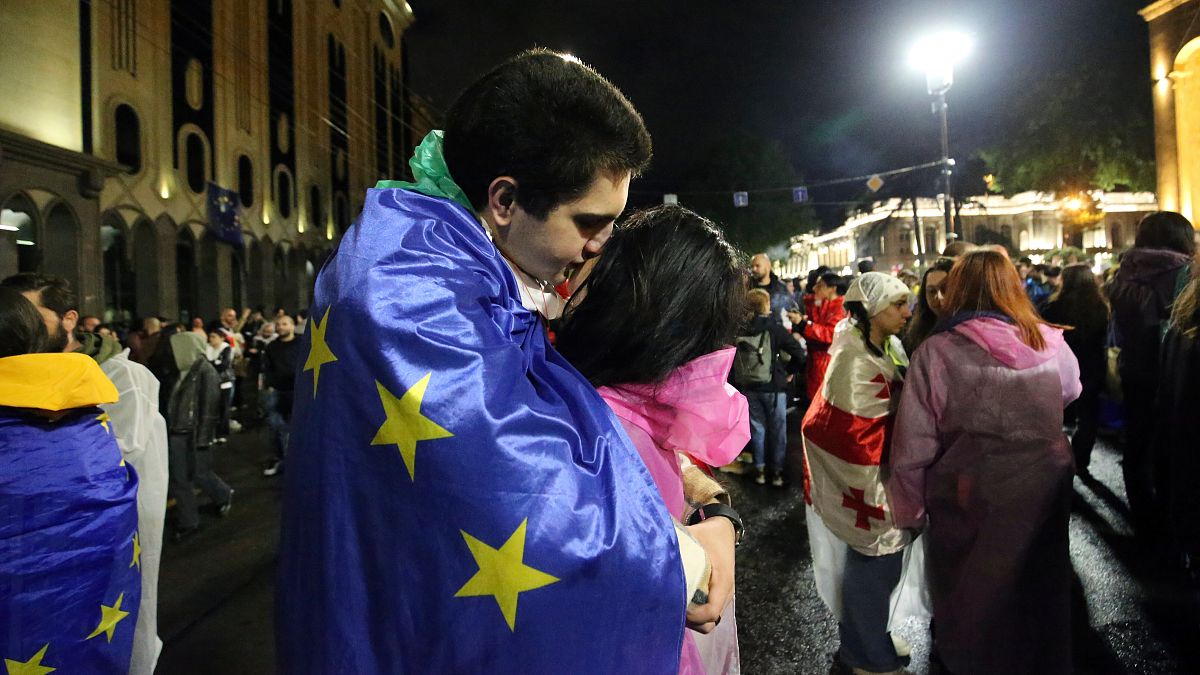The yellow-starred standard is most commonly associated with the EU, but it has a much longer history — and some Europeans seem to despise it.
Few flags the world over are as recognisable as the flag of Europe. Created in 1955, the 12 stars on a blue background are used throughout the international realm as the official standard of the EU.
Yet the flag was only adopted to represent what were then the European Communities in 1985, and it only lodged in the public mind as the European Union’s primary symbol in the 21st century. Its original purpose was to represent the Council of Europe.
According to the European Commission’s official description of the flag, its 12 stars do not represent member states; instead, they “stand for the ideals of unity, solidarity and harmony among the peoples of Europe”.
Its adoption by the European Communities in the 1980s was controversial, with some members concerned it was part of a trend toward the creation of a European superstate with all the trappings of a nation and the ambition to supersede its member governments.
The UK was particularly peeved at a suggested alteration to the design that featured a prominent “E” in the middle of the circle of stars because it very closely resembled the Queen’s personal standard.
These concerns were assuaged (by the omission of the E, for a start), and the flag is now embedded as the preeminent symbol of “Europeanism”.
Aside from its presence on everything from passports to car number plates to food packaging, it is also frequently a target for right-wing political figures opposed to the EU in its current form.
Love it or leave it
In one infamous incident in 2014, Dutch anti-immigration and anti-Islam politician Geert Wilders — whose party topped the polls in his country’s most recent election — staged a stunt where he cut one of the stars out of the flag, an attention-grabbing representation of his proposal that the Netherlands leave the EU.
On the other side, anti-Brexit politicians and activists, known as “remainers”, continue to take up the flag in protest at the UK’s departure from the EU.
The 2019 New Year’s celebrations in heavily pro-Remain London saw the London Eye lit in European colours.
The flag is now a fixture among the audience at the Last Night of the Proms, an event previously heavily dominated by the UK’s own Union Jack. Many on the UK’s cultural right have expressed their outrage at the spectacle.
Meanwhile, in countries yet to join the EU, the flag stands for much more than just the bloc itself — as it was always meant to.
It has been prominently displayed at the furious protests in Georgia against the passage of a so-called “Russian law” that many in the country fear signals a turn away from European values towards Russian-style authoritarianism.
The scenes on the streets of Tbilisi have been reminiscent of those in Kyiv’s Maidan Square in 2013, where pro-European demonstrators rose up in anger against Russian interference in their country’s politics — a protest that sparked a violent crackdown followed by Russia’s first partial invasion of Ukraine and annexation of Crimea in 2014.
The European flag was one of the symbols of the protests dubbed Euromaidan.
Both Georgia and Ukraine are candidates for EU membership — albeit with some way to go before accession — and in both cases, the flag has been raised front and centre by people and parties keen to turn toward Europe and away from Russia.
The flag is also highly visible in other non-EU countries with aspirations to membership. It flies prominently in Kosovo, which is not even a full member of the Council of Europe and still does not enjoy universal international recognition as an independent state.
But it’s not just in politics that the flag carries weight. At the 2024 Eurovision Song Contest, several fans who brought it with them had it confiscated after the European Broadcasting Union (EBU) decided to keep the arena as apolitical a space as possible amid extremely high tensions over Israel’s participation.
As one Moldovan fan told Euronews, many were bitterly disheartened at the symbolism of the flag being banned.
“When we were told that the European flag is banned at the ESC, we were left confused, frustrated that there was nothing we could do, and very disappointed,” Dorin Frăsîneanu said.
“The European flag embodies the aspirations and ideals of an entire generation of young people from all corners of Europe and our collective desire to live in a Europe where freedom, peace, and cooperation reign supreme.”
In a particularly ironic twist, Frăsîneanu pointed out that at the 2023 contest, audience members were, in fact, handed European flags to wave — this at a contest taking place in the UK, the only country to date to have renounced its EU membership.

